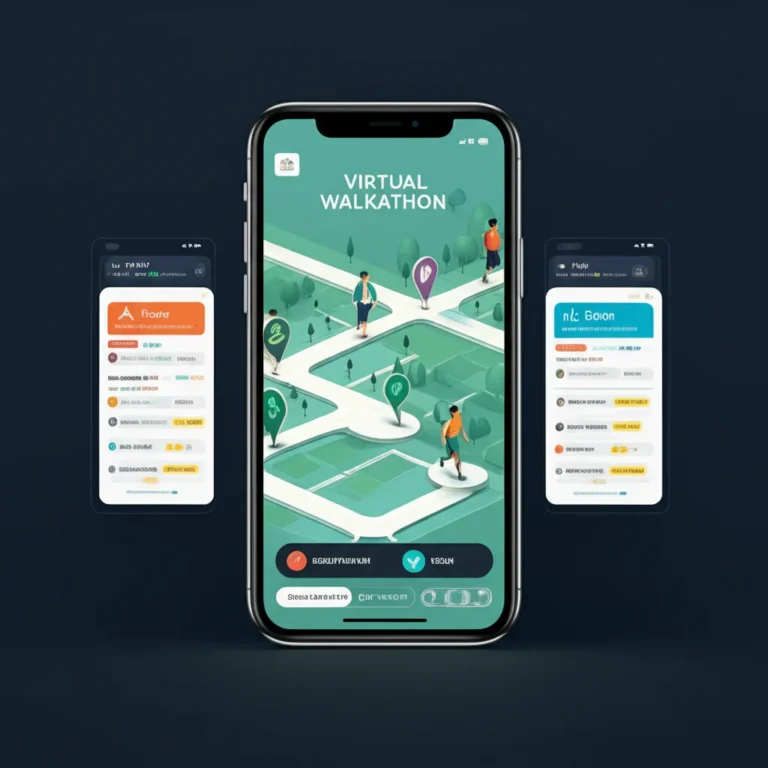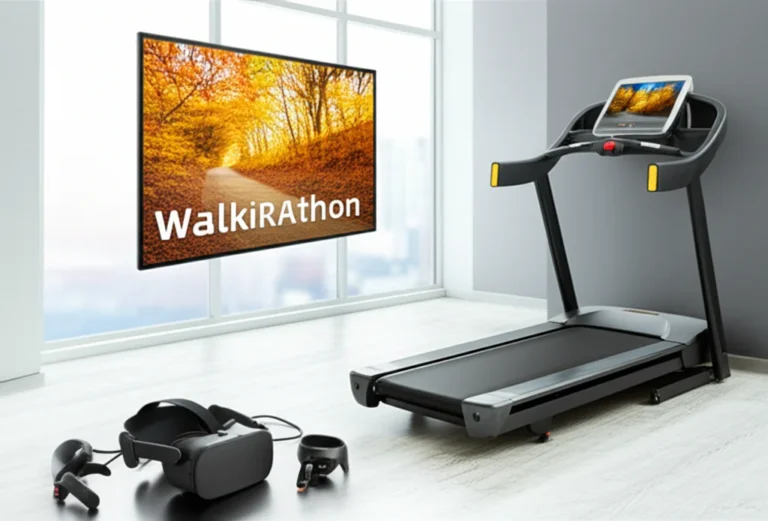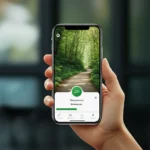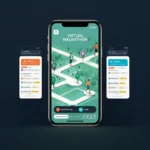Support our educational content for free when you purchase through links on our site. Learn more
What Does a Virtual Walk Mean? 🌍 Unlock 7 Surprising Insights (2025)
Imagine stepping onto a treadmill and suddenly finding yourself strolling through the bustling streets of Tokyo or wandering the serene trails of the Swiss Alps—all without leaving your living room. Sounds like sci-fi? Welcome to the world of virtual walks! But what exactly does a virtual walk mean, and why is it rapidly transforming fitness, fundraising, real estate, and even social connection?
In this article, we’ll unravel the mystery behind virtual walks, explore the different types—from immersive VR adventures to interactive map challenges—and reveal how you can create or join one yourself. Plus, we’ll share insider tips from our Walkathon Virtual™ trainers on how virtual walks can supercharge your motivation and wellness. Curious about the tech behind it? Or wondering how virtual walks are reshaping global events? Stick around, because the future of walking is more exciting than you think!
Key Takeaways
- Virtual walks simulate real or imagined routes using technology like 360° videos, VR headsets, or interactive maps, making fitness and exploration accessible anywhere.
- There are 4 main types: 360-degree tours, augmented reality (AR) walks, virtual reality (VR) immersive experiences, and interactive map-based challenges.
- Virtual walks boost motivation and endurance by engaging your senses and distracting from workout fatigue, proven by science and real user stories.
- They’re revolutionizing fundraising and community events, enabling global participation without geographic limits.
- Creating your own virtual walk is easier than ever with tools like Insta360 cameras and platforms such as Matterport or Kuula.
- Future trends include AI-generated worlds, social metaverse walks, and haptic feedback for next-level immersion.
Ready to explore the best gear and apps to get started? Check out:
- 360° Cameras: Insta360 X4 | Ricoh Theta Z1
- Fitness Apps: Kinomap | Peloton | NordicTrack with iFIT
Table of Contents
- ⚡️ Quick Tips and Facts About Virtual Walks
- 🌟 Understanding Virtual Walks: What Does It Really Mean?
- 📜 The Evolution of Virtual Walks: From Concept to Reality
- 🛠️ Types of Virtual Walks: Exploring Different Formats and Technologies
- 🌐 Where to Publish and Share Your Virtual Walks: Best Platforms and Integration Tips
- 🏡 The Power of 3D Virtual Walkthroughs: Advantages for Real Estate, Tourism, and More
- 🎯 How Virtual Walks Enhance Fitness and Wellness: A New Way to Stay Active
- 💡 Creating Your Own Virtual Walk: Tools, Tips, and Tricks from the Pros
- 🔍 Common Questions About Virtual Walks Answered
- 🧠 The Future of Virtual Walks: Trends and Innovations to Watch
- 🎉 Conclusion: Why Virtual Walks Are Here to Stay
- 🔗 Recommended Links for Virtual Walk Enthusiasts
- ❓ FAQ: Your Burning Questions About Virtual Walks
- 📚 Reference Links and Resources
Here at Walkathon Virtual™, we’ve seen it all. From seasoned marathoners to folks just getting off the couch, the one thing everyone wants is a way to make fitness exciting and accessible. And let me tell you, the world of virtual walks has blown the doors wide open! But what does “virtual walk” even mean? Is it a video game? A fancy slideshow? A workout for your thumbs? 🤔
Strap in, because we’re about to take you on a journey through this amazing digital landscape. We’ll demystify the tech, share some insider tips, and show you how you can explore the globe without ever packing a suitcase.
⚡️ Quick Tips and Facts About Virtual Walks
In a hurry? Here’s the lowdown on virtual walks in 60 seconds.
- What it is: A virtual walk is a simulated experience of walking through a real or fictional location using technology like videos, 360° imagery, or interactive maps.
- Fitness Integration: You can pair virtual walks with a treadmill, elliptical, or stationary bike to make indoor cardio sessions feel like an outdoor adventure. 🏃♀️💨
- Beyond Fitness: The term also applies to virtual tours in real estate, museums, and even for fundraising ideas!
- Accessibility King: It breaks down barriers. People with mobility issues, tight schedules, or those living in unsafe neighborhoods can still experience the joy of walking in new places.
- Tech Needed: It can be as simple as watching a YouTube video on your phone or as immersive as using a VR headset like a Meta Quest 3.
- Global Community: Many platforms connect you with others, letting you join Global Walkathon Events or race against friends in different countries. 🌍
🌟 Understanding Virtual Walks: What Does It Really Mean?
So, what’s the big deal? At its core, a virtual walk is an umbrella term for using technology to simulate the experience of being somewhere else. It’s about transportation in the most magical sense—moving your mind and senses, even if your feet are planted firmly in your living room.
Think of it as the ultimate “try before you buy” for travel, a motivational tool for your workout, or a powerful way to connect with a cause.
For us in the fitness world, it’s a game-changer. One of our trainers, Chloe, worked with a client who was recovering from surgery and couldn’t leave the house. He was feeling down, missing his daily hikes. We set him up with the Wonders of the World walking series on YouTube on his tablet, propped up on his treadmill. The next week, he was ecstatic. He’d “walked” the Great Wall of China and “hiked” through Machu Picchu. His mood and motivation were transformed. That’s the power we’re talking about!
But it’s not just about fitness. For fundraisers, it’s a revolutionary tool. The team at BetterWorld.org, a platform for good causes, highlights this perfectly. They note that a virtual walk is about fostering “community unity, gathering around a shared cause, and effecting tangible change in the world, all from the comfort of your own home.” It’s about shared experience and purpose, transcending physical location.
So, a virtual walk can be:
- A high-definition video of a trail that you watch while on a treadmill.
- An interactive 360° tour of a property for sale.
- A Google Maps route that you “walk” by advancing a pin and seeing Street View images.
- A fully immersive VR experience where you explore a digital re-creation of Rome.
It’s not one single thing; it’s a concept powered by a whole spectrum of cool tech.
📜 The Evolution of Virtual Walks: From Concept to Reality
The idea of “armchair travel” isn’t new. People have been doing it with books and photographs for centuries! But the digital version? That’s a more recent story.
You could say the seeds were planted with early video games that let you explore digital worlds. But the real turning point for reality-based virtual walks was the launch of Google Street View in 2007. Suddenly, you could digitally “stand” on almost any street corner in the world. It was mind-blowing! 🤯
Early fitness applications were pretty basic—videos of trails you could play on a loop. But then, things got interactive.
- The Rise of Apps: Companies like Kinomap and BitGym started syncing these videos to your exercise speed. The video speeds up when you pedal faster and slows down when you do. This created a feedback loop that made the experience far more immersive.
- The Pandemic Boom: The COVID-19 pandemic was a massive catalyst. With gyms closed and travel restricted, everyone was looking for ways to stay active and sane at home. Virtual walks, races, and challenges exploded in popularity. It became a lifeline for both physical and mental health, connecting people when they had to stay apart.
- Hardware Integration: Brands like Peloton and NordicTrack integrated stunning scenic rides and runs directly into their equipment, led by world-class trainers. This seamless experience set a new standard for at-home fitness.
From a simple idea to a multi-billion dollar industry, the virtual walk has proven it’s more than a novelty. It’s a fundamental shift in how we approach fitness, exploration, and community.
🛠️ Types of Virtual Walks: Exploring Different Formats and Technologies
Not all virtual walks are created equal! The experience can range from simple and free to mind-bendingly immersive. Let’s break down the main types you’ll encounter.
1. 360-Degree Virtual Walks and Tours
This is what most people think of when they hear “virtual tour.” It uses a series of panoramic photos or videos stitched together. You can click or drag to look around in any direction, and click on “hotspots” to move from one point to another.
- ✅ Pros: Highly accessible (works in any web browser), relatively easy to create, great for showcasing a specific space like a house or museum.
- ❌ Cons: Can feel a bit static (“jumping” from point to point), not usually synced with physical movement.
- Best For: Real estate listings (Zillow 3D Home tours), museum tours (The British Museum’s virtual tour), and business showcases.
2. Augmented Reality (AR) Walks
AR overlays digital information onto your view of the real world, usually through your smartphone camera. Think of it as a virtual walk that enhances your actual walk.
- ✅ Pros: Encourages you to get outside, highly interactive and engaging, can be used for games or educational purposes.
- ❌ Cons: Requires you to be in a specific physical location, dependent on your phone’s battery and data.
- Best For: Gamified fitness like Pokémon GO, historical walking tours that show “then and now” images, or educational apps like Star Walk that identify constellations as you walk at night.
3. Virtual Reality (VR) Immersive Walks
This is the holy grail of virtual exploration! By wearing a VR headset, you are completely transported to another place. The world moves with your head, and with controllers, you can interact with the environment.
- ✅ Pros: The highest level of immersion possible, truly feels like you’re there, blocks out all distractions.
- ❌ Cons: Requires expensive, specialized hardware (Meta Quest, HTC Vive), can cause motion sickness in some users.
- Best For: High-end fitness experiences (Supernatural), realistic travel apps (Wander on Meta Quest), and advanced training simulations.
4. Interactive Map-Based Virtual Walks
These walks use mapping services like Google Maps to plot a route. As you log your distance (either manually or via a fitness tracker), your icon moves along the map, often unlocking milestones and showing you Street View images of your “location.” This is the core of many virtual fitness challenges.
- ✅ Pros: Highly motivational for long-term goals (like “walking” Route 66), fosters a sense of progress, can be done from anywhere with any type of exercise.
- ❌ Cons: Less visually immersive than video or VR, relies on static images.
- Best For: Virtual walkathons, corporate wellness challenges, and long-distance fundraising ideas. Platforms like MyVirtualMission excel at this.
| Feature | 360° Tour | AR Walk | VR Walk | Map-Based Walk |
|---|---|---|---|---|
| Immersion Level | Low-Medium | Medium | High | Low |
| Equipment Needed | Phone/Computer | Smartphone | VR Headset | Any Device |
| Best Use Case | Real Estate | Outdoor Gaming | Immersive Fitness | Fitness Challenges |
| Physical Location | Anywhere | Specific Location | Anywhere | Anywhere |
🌐 Where to Publish and Share Your Virtual Walks: Best Platforms and Integration Tips
Creating a virtual walk is one thing; getting people to see it is another! Whether you’re a real estate agent, a fitness influencer, or a non-profit organizer, choosing the right platform is key. Effective event promotion depends on it!
For 3D and 360° Tours (Real Estate, Business)
- Matterport: The industry standard for creating high-quality 3D “digital twins” of physical spaces. You can easily embed their tours on your website.
- Kuula: A user-friendly and affordable platform for creating and sharing 360° virtual tours. Great for photographers and small businesses.
- Social Media: You can upload 360° photos directly to Facebook. It’s a great way to give your followers an interactive peek into your space.
For Fitness and Wellness Walks
- YouTube: The easiest and most accessible option. Film a walk, upload it, and anyone can watch. Search for “treadmill scenery” or “virtual walk” and you’ll find thousands of options.
- Interactive Fitness Apps: If you want your walk to sync with exercise equipment, you’ll need a dedicated app.
- Kinomap: Features thousands of user-generated videos from around the world that sync with treadmills, bikes, and rowers.
- Zwift: While more focused on cycling and running in fictional worlds, it’s a powerhouse of social virtual exercise.
- Peloton: Offers a huge library of high-production value scenic rides and runs as part of their subscription.
For Virtual Walkathon Fundraisers
- Dedicated Challenge Platforms: These platforms handle registration, distance tracking, and fundraising all in one place.
- MyVirtualMission: Lets you create custom map-based challenges for your group or company.
- BetterWorld: As mentioned, they offer a fantastic, user-friendly platform specifically designed for fundraisers, including virtual walkathons.
Pro Tip: No matter where you host it, embed your virtual walk on your own website or landing page. This creates a central hub for your event, improves your site’s SEO, and gives you full control over the surrounding messaging.
🏡 The Power of 3D Virtual Walkthroughs: Advantages for Real Estate, Tourism, and More
While we live and breathe the fitness side of things at Walkathon Virtual™, the impact of virtual walks in other industries is just too big to ignore. A 3D virtual walkthrough isn’t just a cool gadget; it’s a powerful business tool that saves time, money, and headaches.
Have you ever tried to book a hotel room based on a few flattering, wide-angle photos, only to arrive and find it’s the size of a closet? 🙋♀️ A virtual walk eliminates that deception. It provides transparency and builds trust.
Here’s how different sectors are cashing in on the benefits:
| Industry | Key Advantage | How It Works | Real-World Example |
|---|---|---|---|
| Real Estate | Qualifies Leads & Saves Time | Buyers can thoroughly explore a property online, weeding out ones that aren’t a fit without a physical visit. Agents spend time on serious buyers only. | A Zillow listing with a 3D Home tour gets more views and saves, leading to a faster sale. |
| Tourism & Hospitality | Boosts Bookings & Manages Expectations | Potential guests can “walk” through a hotel, cruise ship, or resort, seeing the exact room, pool, and amenities. This confidence leads to more bookings. | A resort can showcase its beachfront access, restaurant ambiance, and room views, setting it apart from competitors with just static photos. |
| Museums & Culture | Increases Accessibility & Global Reach | People from anywhere in the world can explore priceless collections and historical sites, breaking down geographical and physical barriers. | The Louvre offers virtual tours, allowing art lovers to see the Mona Lisa without the crowds. |
| Construction & Architecture | Improves Collaboration & Catches Errors | Architects and clients can “walk” through a building before it’s built, making design changes and catching potential issues early in the process. | Using software like Autodesk Revit, a team can identify a poorly placed doorway in the virtual model, saving thousands in rework costs. |
| Retail | Creates Engaging Shopping Experiences | Brands can create virtual showrooms where customers can browse products in a simulated, high-end environment from their own home. | A luxury car brand like Porsche might offer a virtual tour of its latest model’s interior. |
The common thread? Immersion builds confidence. When a customer can virtually experience something, they feel more informed and are more likely to take the next step, whether that’s booking a room, scheduling a viewing, or making a purchase.
🎯 How Virtual Walks Enhance Fitness and Wellness: A New Way to Stay Active
Okay, let’s get back to our home turf: your health! 🩺 This is where we at Walkathon Virtual™ get really excited. A virtual walk isn’t just a distraction; it’s a powerful psychological tool that can revolutionize your relationship with exercise.
The biggest enemy of any fitness routine? Boredom. Staring at the same wall while on a treadmill is a recipe for quitting. A virtual walk smashes that boredom to pieces.
H3: The Science of Distraction and Motivation
Your brain can only focus on so much at once. When you’re immersed in a stunning visual of the Swiss Alps or the coast of California, you’re less focused on the burning in your legs or the minutes ticking by. This concept, known as attentional focus, is well-documented. An external focus (the beautiful scenery) is often more effective for endurance than an internal focus (your physical discomfort).
This leads to:
- Increased Endurance: You’re likely to go longer and farther because you’re genuinely enjoying yourself.
- Higher Consistency: When you look forward to your “trip” to Japan or your “hike” in a National Park, you’re more likely to show up for your workout day after day.
- Mental Health Boost: “Travel” and exposure to nature (even digitally) can reduce stress and improve mood. The health benefits of walkathons, even virtual ones, are immense.
H3: Our Favorite Fitness Apps and Setups
Ready to try it? Here’s a setup for every level:
-
The Free & Easy Setup:
- Grab your smartphone or tablet.
- Go to YouTube and search for “virtual treadmill walk” or “scenic bike ride.”
- Prop your device on your treadmill or bike and press play. That’s it!
-
The Interactive App Setup:
-
The All-In-One Ecosystem:
- Invest in equipment from brands like NordicTrack (with iFIT) or Peloton.
- Their scenic rides and runs are seamlessly integrated into the machine’s screen, often led by trainers who provide coaching and interesting facts about the location. It’s the most polished, but also the most expensive, option.
No matter which you choose, you’re transforming a mundane workout into an exciting escape. It’s one of the best distance walking techniques for crushing long-term goals.
💡 Creating Your Own Virtual Walk: Tools, Tips, and Tricks from the Pros
Ever been on a beautiful hike and thought, “I wish I could share this exact experience with my friends”? Well, you can! Creating your own virtual walk is more accessible than ever. Whether you want to capture a favorite local trail or create a 360° tour of your small business, here’s how to get started.
H3: The Gear You’ll Need
You can start simple or go full-pro.
-
Basic (Video Walk):
- Your Smartphone: Modern phones have incredible video stabilization.
- A Gimbal: This is the secret sauce! A gimbal like the DJI Osmo Mobile will make your footage buttery smooth. Shaky-cam is the #1 enemy of a good virtual walk.
-
Advanced (360° Walk):
- A 360° Camera: These cameras capture everything around you at once. They are the key to creating truly interactive tours.
- Insta360 X4: A fantastic all-around choice, known for its great software and “invisible selfie stick” feature.
- Ricoh Theta Z1: A pro-level option prized by real estate photographers for its exceptional image quality.
- A 360° Camera: These cameras capture everything around you at once. They are the key to creating truly interactive tours.
👉 Shop 360° Cameras on:
- Insta360 X4: Amazon | Walmart | Insta360 Official Website
- Ricoh Theta Z1: Amazon | Ricoh Official Website
H3: Step-by-Step Guide to a Smooth Video Walk
- Plan Your Route: Know where you’re going. Choose a time with good lighting (early morning or late afternoon is best) and fewer crowds.
- Stabilize Your Shot: Mount your phone on a gimbal. Hold it steady and walk at a consistent, natural pace. Try to keep the horizon level.
- Walk Smoothly: Bend your knees slightly as you walk. This is a pro videographer trick called the “ninja walk” that absorbs the bobbing motion.
- Think About Audio: Do you want the natural sounds of birds chirping? Or will you add music or a voiceover later? If you want natural sound, a small external microphone can reduce wind noise.
- Edit Simply: You don’t need fancy software. Use a simple editor to trim the start and end, and maybe do some minor color correction. The goal is a long, uninterrupted shot.
- Upload and Share: Put it on YouTube, Vimeo, or your platform of choice!
Creating a 360° tour is a bit more involved, requiring you to take photos at set intervals and then stitch them together using software like Kuula or Matterport, but the immersive result can be well worth the effort.
🔍 Common Questions About Virtual Walks Answered
We get a lot of questions from people dipping their toes into the world of virtual fitness and exploration. Let’s tackle some of the most common ones head-on.
-
“Do I need a treadmill to do a virtual walk?”
- Absolutely not! That’s the beauty of it. You can use a stationary bike, an elliptical, a stepper, or even just march in place in your living room. The goal is to get moving while your mind is exploring.
-
“Will these apps drain my phone’s data?”
- Yes, if you’re streaming. High-definition video uses a lot of data. We highly recommend downloading walks or videos over Wi-Fi before you start your workout. Most apps like YouTube Premium, Peloton, and Kinomap offer a download feature for offline use.
-
“Is the equipment expensive?”
- It doesn’t have to be. You can start for free with YouTube and your phone. A subscription to an app like Kinomap is often less than a single month at a gym. The high-end, integrated machines are a significant investment, but they are by no means required to get the benefits.
-
“I get motion sickness easily. Is VR out for me?”
- Not necessarily. Many people who experience motion sickness in VR games find that stationary experiences (where you don’t “move” with a joystick) are perfectly fine. Apps like Brink Traveler use a “teleport” system to move, which is much easier on the stomach. Start with short sessions (5-10 minutes) to build up your “VR legs.”
🧠 The Future of Virtual Walks: Trends and Innovations to Watch
If you think what we have now is cool, just wait. The future of virtual walks is heading towards a level of realism and interactivity that sounds like science fiction. So, what’s on the horizon?
-
The Metaverse and Social Hangouts: The future isn’t just about walking through a place; it’s about walking through it with people. Imagine meeting your friend from another continent for a virtual walk through a digital twin of Paris, chatting in real-time as your avatars stroll down the Champs-Élysées. Platforms like Meta Horizon Worlds are just the beginning.
-
AI-Generated Worlds: What if you could walk through a world created from your imagination? With advancements in generative AI, you might soon be able to type “a walk through a glowing mushroom forest on an alien planet at sunset,” and an entire world will be created for you to explore.
-
Haptic Feedback: The next step in immersion is feeling the walk. Haptic suits or accessories could simulate the feeling of wind on your face, the incline of a hill through resistance on your treadmill, or even the temperature change as you move from sun to shade.
-
The Science of Us: This might be the most fascinating part. Scientists are already analyzing the data from our virtual movements. In a mind-bendingly complex paper, researchers explored how virtual walks can model social opinion dynamics, showing that our collective digital paths can reflect real-world social patterns (arXiv:2202.11761). The paper notes, “The walks show the features of a biased random walk below p_c, and above p_c, the walks are like unbiased random walks.” In simple terms, the virtual trails we blaze are creating data that helps us understand complex human behavior. The future isn’t just about seeing new places; it’s about understanding ourselves on a deeper level.
The line between the real and virtual worlds is blurring, and for fitness, travel, and human connection, that’s an incredibly exciting prospect.
🎉 Conclusion: Why Virtual Walks Are Here to Stay
Well, there you have it — the full scoop on what a virtual walk means and why it’s become such a powerhouse in fitness, fundraising, real estate, and beyond. From humble beginnings as simple videos to immersive VR experiences and AI-generated worlds, virtual walks have evolved into a versatile tool that breaks barriers and brings people together.
For fitness enthusiasts, virtual walks turn the treadmill into a gateway to the world, making workouts more engaging and sustainable. For fundraisers, they create inclusive, global communities rallying around causes without geographical limits. And for businesses, especially in real estate and tourism, they offer transparency and trust through immersive 3D tours.
Remember Chloe’s client, who found new motivation by “walking” the Great Wall of China from his treadmill? That’s not just a feel-good story; it’s a testament to how virtual walks can transform lives.
If you’re wondering whether to dip your toes in or dive headfirst, our advice is simple: start small, experiment, and find what excites you. Whether it’s a YouTube scenic walk or a full VR adventure, the benefits are real and accessible.
Virtual walks are not a passing fad — they’re a new way to move, explore, and connect. So lace up those shoes (or just slip on your slippers), and step into the future of walking.
🔗 Recommended Links for Virtual Walk Enthusiasts
Ready to gear up or dive deeper? Here are some top picks and resources to get you started:
-
360° Cameras:
- Insta360 X4: Amazon | Walmart | Insta360 Official Website
- Ricoh Theta Z1: Amazon | Ricoh Official Website
-
Fitness Apps & Equipment:
- Kinomap: Official Site
- BitGym: Official Site
- Peloton: Official Site
- NordicTrack with iFIT: Official Site
-
Virtual Walkathon Platforms:
- BetterWorld: betterworld.org
- MyVirtualMission: myvirtualmission.com
-
Books on Virtual Fitness and Motivation:
❓ FAQ: Your Burning Questions About Virtual Walks
What is a virtual walkathon and how does it work?
A virtual walkathon is a fundraising or community event where participants complete walking challenges remotely rather than gathering in one physical location. Participants register online, choose their own routes or use virtual walk platforms, and log their distances via apps or fitness trackers. The event organizers often provide digital resources, social media groups, and incentives to keep motivation high. This format allows people worldwide to join, making it inclusive and flexible. You can learn more about organizing and participating in virtual walkathons on our Fundraising Ideas page.
How do I participate in a virtual walking event?
Participation is usually straightforward:
- Register: Sign up on the event’s website or platform.
- Choose Your Route: Walk anywhere — your neighborhood, a park, or even indoors on a treadmill.
- Track Your Distance: Use a smartphone app, fitness tracker, or manual logging.
- Engage: Join virtual meetups, share progress on social media, and connect with other walkers.
- Celebrate: Receive digital badges, certificates, or swag for milestones.
Many events provide training plans and motivational content to help you prepare and stay engaged.
What are the benefits of joining a virtual walkathon?
Virtual walkathons offer multiple benefits:
- Accessibility: Participate regardless of location, mobility, or schedule.
- Community: Connect with like-minded people globally.
- Health: Improve physical and mental well-being through regular activity.
- Fundraising: Support causes you care about without logistical hassles.
- Flexibility: Walk at your own pace and time, making it easier to fit into busy lives.
Our trainers have seen participants report higher motivation and a stronger sense of purpose when joining virtual walkathons compared to solo workouts.
Can I organize my own virtual walkathon and how do I get started?
Absolutely! Organizing a virtual walkathon involves:
- Define the Cause and Goals: What are you fundraising for? How many participants do you want?
- Choose a Platform: Use services like BetterWorld or MyVirtualMission to manage registrations, tracking, and donations.
- Plan the Event: Set dates, create training resources, and design incentives.
- Promote: Use social media, email, and word-of-mouth to spread the word. Check out our Event Promotion tips.
- Engage Participants: Host virtual meetups, share updates, and celebrate milestones.
- Thank Supporters: Show appreciation to build lasting relationships.
We recommend starting with a small pilot event to iron out logistics before scaling up.
Are virtual walks effective for weight loss and fitness?
Yes! Virtual walks can be highly effective when combined with consistent effort. The immersive and motivational aspects help users stick to their routines longer, which is crucial for weight loss and cardiovascular health. However, like any exercise, results depend on intensity, duration, and frequency. Pairing virtual walks with a balanced diet and strength training yields the best outcomes.
Can virtual walks replace outdoor walking entirely?
While virtual walks are fantastic for accessibility and variety, they’re not a complete substitute for outdoor walking. Outdoor walks provide fresh air, natural terrain, and social interaction that are hard to replicate virtually. However, virtual walks are an excellent supplement, especially when weather, safety, or mobility issues limit outdoor activity.
📚 Reference Links and Resources
- Google Street View — https://www.google.com/streetview/
- BetterWorld Virtual Walk Fundraising Platform — https://betterworld.org/
- Kinomap Interactive Fitness App — https://www.kinomap.com/
- Peloton Official Site — https://www.onepeloton.com/
- Matterport 3D Virtual Tours — https://matterport.com/
- Insta360 Cameras — https://www.insta360.com/
- Ricoh Theta Z1 — https://us.ricoh-imaging.com/product/theta-z1/
- Meta Quest VR Headsets — https://www.meta.com/quest/quest-3/
- Research Paper: Virtual walks inspired by a mean field kinetic exchange model of opinion dynamics — https://arxiv.org/abs/2202.11761
For more on virtual walks and fitness, explore our categories on Health Benefits of Walkathons and Distance Walking Techniques.





